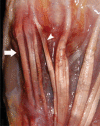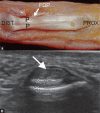Ultrasound anatomy of the fingers: flexor and extensor system with emphasis on variations and anatomical detail
- PMID: 32609968
- PMCID: PMC7418857
- DOI: 10.15557/JoU.2020.0020
Ultrasound anatomy of the fingers: flexor and extensor system with emphasis on variations and anatomical detail
Abstract
Many anatomical details and variants occur in the finger tendons and soft tissue structures. These may lead to misdiagnosis if the radiologist is not well aware of them. We discuss the midhand extensor tendons, dorsal hood, junctura tendinea, conjoint tendons, transverse retinacular ligament, triangular ligament as well as central and distal slip anatomy and ultrasound correlation. The dorsal hood is an important structure to center the tendons at the midportion of the MCP heads, and the sagittal bands are its main components. Two tendons are present at the second digit, and two or more at the fifth digit. The extensor mechanism is anatomically interrelated with the palmar lumbricals and interosseous tendons. At the palmar side, the flexor superficialis and profundus tendons show varying relationships along the finger. The flexor profundus passes through an opening in the flexor superficialis. We also discuss the chiasma crurale, ridges at the flexor superficialis insertions and bifid flexor profundus tendon. Although a typical distribution of annular pulleys can be observed, many variants may be present of which we address some. The volar plate is a midline fibro-cartilaginous meniscus attached proximally to the well-identifiable checkrein ligaments and distally to the base of the phalanges. Knowledge of these details and variations allows for better understanding of the finger and hand ultrasound.
Many anatomical details and variants occur in the finger tendons and soft tissue structures. These may lead to misdiagnosis if the radiologist is not well aware of them. We discuss the midhand extensor tendons, dorsal hood, junctura tendinea, conjoint tendons, transverse retinacular ligament, triangular ligament as well as central and distal slip anatomy and ultrasound correlation. The dorsal hood is an important structure to center the tendons at the midportion of the MCP heads, and the sagittal bands are its main components. Two tendons are present at the second digit, and two or more at the fifth digit. The extensor mechanism is anatomically interrelated with the palmar lumbricals and interosseous tendons. At the palmar side, the flexor superficialis and profundus tendons show varying relationships along the finger. The flexor profundus passes through an opening in the flexor superficialis. We also discuss the chiasma crurale, ridges at the flexor superficialis insertions and bifid flexor profundus tendon. Although a typical distribution of annular pulleys can be observed, many variants may be present of which we address some. The volar plate is a midline fibro-cartilaginous meniscus attached proximally to the well-identifiable checkrein ligaments and distally to the base of the phalanges. Knowledge of these details and variations allows for better understanding of the finger and hand ultrasound.
Conflict of interest statement
Figures


















References
-
- Chiavaras MM, Jacobson JA, Yablon CM, Brigido MK, Girish G: Pitfalls in wrist and hand ultrasound. AJR Am J Roentgenol 2014; 203: 531–540. - PubMed
-
- Starr HM Jr, Sedgley MD, Means KR Jr, Murphy MS: Ultrasonography for hand and wrist conditions. J Am Acad Orthop Surg 2016; 24: 544–554. - PubMed
-
- Tagliafico A, Rubino M, Autuori A, Bianchi S, Martinoli C: Wrist and hand ultrasound. Semin Musculoskelet Radiol 2007; 11: 95–104. - PubMed
-
- Bianchi S, Martinoli C, Sureda D, Rizzatto G: Ultrasound of the hand. Eur J Ultrasound 2001; 14: 29–34. - PubMed
-
- Kichouh M, De Maeseneer M, Jager T, Marcelis S, Van Hedent E, Van Roy P et al. : Ultrasound findings in injuries of dorsal extensor hood: correlation with MR and follow-up findings. Eur J Radiol 2011; 77: 249–253. - PubMed
LinkOut - more resources
Full Text Sources
Miscellaneous
